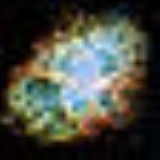
Pulsar wind nebula
Encyclopedia
A pulsar wind nebula (also known as "plerion", derived from Ancient Greek "pleres" meaning "full"—a term coined by Weiler & Panagia [1978]) is a nebula
powered by the pulsar wind of a pulsar
. At the early stages (first few thousands of years) of their evolution, pulsar wind nebulae are often found inside the shells of supernova remnants. However, pulsar wind nebulae have also been found around older pulsars whose supernova remnants have disappeared, including millisecond radio pulsars (e.g. Stappers et al. 2003).
A prototypical pulsar wind nebula is the Crab Nebula
(Hester et al. 2008).
Pulsar winds are composed of charged particles accelerated to relativistic speed by the rapidly rotating, superstrong magnetic field of the spinning pulsar.
The pulsar wind streams into the interstellar medium, creating a standing shock wave
, where it is decelerated to sub-relativistic speed. Beyond this radius synchrotron
emission increases in the magnetized flow.
Pulsar wind nebulae often show the following properties:
Pulsar wind nebulae can be powerful probes of a pulsar's interaction with its surroundings — their properties can be used to infer the geometry, energetics, and composition of the pulsar wind, the space velocity of the pulsar itself, and the properties of the ambient medium (Gaensler & Slane 2006).
Nebula
A nebula is an interstellar cloud of dust, hydrogen gas, helium gas and other ionized gases...
powered by the pulsar wind of a pulsar
Pulsar
A pulsar is a highly magnetized, rotating neutron star that emits a beam of electromagnetic radiation. The radiation can only be observed when the beam of emission is pointing towards the Earth. This is called the lighthouse effect and gives rise to the pulsed nature that gives pulsars their name...
. At the early stages (first few thousands of years) of their evolution, pulsar wind nebulae are often found inside the shells of supernova remnants. However, pulsar wind nebulae have also been found around older pulsars whose supernova remnants have disappeared, including millisecond radio pulsars (e.g. Stappers et al. 2003).
A prototypical pulsar wind nebula is the Crab Nebula
Crab Nebula
The Crab Nebula is a supernova remnant and pulsar wind nebula in the constellation of Taurus...
(Hester et al. 2008).
Pulsar winds are composed of charged particles accelerated to relativistic speed by the rapidly rotating, superstrong magnetic field of the spinning pulsar.
The pulsar wind streams into the interstellar medium, creating a standing shock wave
Shock wave
A shock wave is a type of propagating disturbance. Like an ordinary wave, it carries energy and can propagate through a medium or in some cases in the absence of a material medium, through a field such as the electromagnetic field...
, where it is decelerated to sub-relativistic speed. Beyond this radius synchrotron
Synchrotron
A synchrotron is a particular type of cyclic particle accelerator in which the magnetic field and the electric field are carefully synchronised with the travelling particle beam. The proton synchrotron was originally conceived by Sir Marcus Oliphant...
emission increases in the magnetized flow.
Pulsar wind nebulae often show the following properties:
- An increasing brightness towards the center, without a shell-like structure as seen in most other supernova remnants.
- A highly polarized flux and a flat spectral indexSpectral indexIn astronomy, the spectral index of a source is a measure of the dependence of radiative flux density on frequency. Given frequency \nu and radiative flux S, the spectral index \alpha is given implicitly byS\propto\nu^\alpha....
in the radio band, α=0–0.3. The index steepens at X-ray energies due to synchrotron radiation losses and on the average has an X-ray photon index of 1.3–2.3 (spectral index of 2.3–3.3). - An X-ray size that is generally smaller than their radio and optical size (due to smaller synchrotron lifetimes of the higher-energy electrons) (e.g. Slane et al. 2000).
- A photon index at TeV gamma-ray energies of ~2.3.
Pulsar wind nebulae can be powerful probes of a pulsar's interaction with its surroundings — their properties can be used to infer the geometry, energetics, and composition of the pulsar wind, the space velocity of the pulsar itself, and the properties of the ambient medium (Gaensler & Slane 2006).

